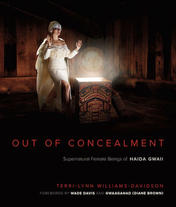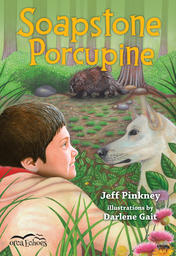Canadian Indigenous Books for Schools 2018/19
Created by ABPBC on November 8, 2018
Once in a Blue Moon
A book that will inspire readers to connect more deeply with the natural world, from the award winning author of Sometimes I Feel Like A Fox.
Inspired by the expression “once in a blue moon,” Danielle Daniel has created a book of short poems, each one describing a rare or special experience that turns an ordinary day into a memorable one. She describes the thrill of seeing a double rainbow, the Northern Lights or a shooting star as well as quieter pleasures such as spotting a turtle basking i …

Oral Traditions and Storytelling
Indigenous peoples have played an influential role in Canadian history and continue to do so today. From the past and into the future, Indigenous Life in Canada reveals the challenges Indigenous peoples face, celebrates their diverse cultures, and highlights the contributions they make in Canada.

Out of Concealment
A stunning collection of powerful and whimsical photo collages celebrating supernatural female beings rooted in Haida culture.
Out of Concealment presents the oral narratives of the Haida Nation through the vibrant depiction of its female supernatural beings. Passed on from generation to generation through oral tradition, these stories are important historical narratives that illustrate the Haida’s values, customs, laws, and relationships with the earthly and metaphysical realms.
This book fea …

Pemmican Wars
Echo Desjardins, a 13-year-old Métis girl adjusting to a new home and school, is struggling with loneliness while separated from her mother. Then an ordinary day in Mr. Bee’s history class turns extraordinary, and Echo’s life will never be the same. During Mr. Bee’s lecture, Echo finds herself transported to another time and place—a bison hunt on the Saskatchewan prairie—and back again to the present. In the following weeks, Echo slips back and forth in time. She visits a Métis camp, …

Pictographs
In Pictographs, Ojibway artist James Simon Mishibinijima brings to life the legends passed down to him by generations of Elders. In this collection of drawings, each image tells a story, silently communicating lessons of harmony, interconnectedness and peace.

Seven Fallen Feathers
Winner, 2017 Shaughnessy Cohen Writers' Trust Prize for Political Writing
Winner, 2017 RBC Taylor Prize
Winner, 2017 First Nation Communities Read: Young Adult/Adult
Winner, 2024 Blue Metropolis First Peoples Prize, for the whole of her work
Finalist, 2017 Hilary Weston Writers’ Trust Prize for Nonfiction
The groundbreaking and multiple award-winning national bestseller work about systemic racism, education, the failure of the policing and justice systems, and Indigenous rights by Tanya Tal …
It’s early April and the 2011 federal election is in full swing. All over Canada, Stephen Harper’s Conservatives are duking it out with Jack Layton’s New Democrats and the struggling Liberals in a bid to win a majority government.
I’m in Thunder Bay, Ontario, to see Stan Beardy, the Nishawbe-Aski Nation’s grand chief, to interview him for a story on why it is indigenous people never seem to vote.
The receptionist at the NAN’s office greets me and ushers me into a large, common meeting room to wait for Stan. Everything in the room is grey — the walls, the tubular plastic tables, the carpets. The only splash of colour is a large white flag with a bear on it that has been tacked to the wall.
The Great White Bear stands in the centre of a red circle, in the middle of the flag. The white bear is the traditional symbol of the life of the North American Indian. The red circle background is symbolic of the Red Man. His feet are standing, planted firmly on the bottom line, representing the Earth while his head touches the top line, symbolic to his relationship to the Great Spirit in the sky. The bear is stretched out, arms and feet open wide, to show he has nothing to hide.
There are circles joining the bear’s rib cage. They are the souls of the people, indigenous songs, and legends. The circles are the ties that bind all the clans together.
These circles also offer protection. Without them, the ribcage would expose the great bear’s beating heart and leave it open to harm.
Stan walks in and greets me warmly, his brown eyes twinkling as he takes a seat.
Stan is pensive, quiet, and patient. He says nothing as he wearily leans back in his chair and waits for me to explain why exactly I flew 2,400 km north from Toronto to see him and talk about the federal election.
I launch into my spiel, trying not to sound like a salesperson or an interloper into his world, someone who kind of belongs here and kind of does not. This is the curse of my mixed blood. I am the daughter of a half-Anish mom and a Polish father.
I ramble off abysmal voting pattern statistics across Canada, while pointing out that in many ridings indigenous people could act as a swing vote, influencing that riding and hence the trajectory of the election.
Stan stares at me impassively. Non-plussed.
So I start firing off some questions.
It doesn’t go well. Every time I try to engage him, asking him about why indigenous people won’t get in the game and vote, he begins talking about the disappearance of fifteen-year-old Jordan Wabasse.
It was a frustrating exchange, like we were speaking two different languages.
“Indigenous voters could influence fifty seats across the country if they got out and voted but they don’t. Why?” I ask.
“Why aren’t you writing a story on Jordan Wabasse? He has been gone seventy-one days now,” replies Stan.
“Stephen Harper has been no friend to indigenous people yet if everyone voted, they could swing the course of this election,” I continue, hoping he’ll bite at the sound of Harper’s name. The man is no friend of the Indians.
“They found a shoe down by the water. Police think it might have been his,” replies Stan.
This went on for a good fifteen minutes. I was annoyed. I knew a missing Grade 9 indigenous student in Thunder Bay would not make news in urban Toronto at Canada’s largest daily newspaper. I could practically see that election bus rolling away without me.
Then I remembered my manners and where I was.
I was sitting with the elected grand chief of 23,000 people and he was clearly trying to tell me something.
I tried a new tactic. I’d ask about Jordan and then I’d swing around and get him to talk about elections.
Then Stan said: “Jordan is the seventh student to go missing or die while at school.”
Seven.
Stan says their names: “Reggie Bushie. Jethro Anderson. Paul Panacheese. Curran Strang. Robyn Harper. Kyle Morrisseau. And now, Jordan Wabasse.”
He then tells me the seven were hundreds of miles away from their home communities and families.
Each was forced to leave their reserve simply because there was no high school for them to attend.
“Going to high school is the right of every Canadian child,” says Stan, adding that these children are no different.

Soapstone Porcupine
The dog shows up the way snow does on a winter's day. She just drifts in and stays, becoming the friend of a young Cree boy. The boy and the dog set out on an adventure that ends in a quandary involving quills and a big brother who swears to take revenge on the porcupine. But Lindy, a Cree elder and master carver, reminds the brothers of the importance of the great porcupine. After a day spent carving in town, the boy learns some truths about human nature and realizes that sometimes, like the p …

The Sockeye Mother
To the Gitxsan people of Northwestern British Columbia, the sockeye salmon is more than just a source of food. Over its life cycle, it nourishes the very land and forests that the Skeena River runs through and where the Gitxsan make their home. The Sockeye Mother explores how the animals, water, soil, and seasons are all intertwined.



